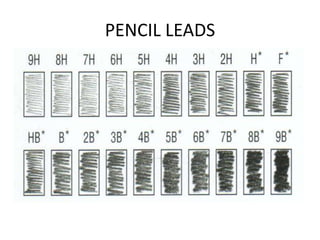
PPT3.pptx
- 1. PENCIL LEADS
- 5. POINTERS FOR EDITORIAL CARTOONING 1. Be most concerned with the originality and clarity of your cartoon's ideas. 2. Select news stories of major continuing interest -- what's news in December may not be news in March. 3. Study some professionally drawn editorial cartoons closely before trying to create one of your own. Remember, study them, but don't copy them. 4. Don't clutter your cartoon with too many different ideas. Decide on a single point you want to make.
- 6. 5. Draw in bold lines. Keep lettering large and legible. 6. Draw your cartoons in a horizontal, not vertical, format. 7. Don't create a cartoon that is just a slogan ("Don't Smoke", "Watch Less TV", etc.) 8. Be funny or thought provoking. Or both.
- 10. HATCHING The most basic method of creating value in ink drawing is linear hatching. Fine parallel lines fill an area, so that from just a slight distance, we have the illusion of value. The closer the lines are, the less white paper shows, and the darker the value appears. Heavier line weight also gives a darker appearance.
- 11. CROSSHATCHING Crosshatching is the drawing of two layers of hatching at right-angles to create a mesh-like pattern. Multiple layers in varying directions can be used to create textures. Crosshatching is often used to create tonal effects, by varying the spacing of lines or by adding additional layers of lines. Crosshatching is used in pencil drawing, but is particularly useful with pen and ink drawing, to create the impression of areas of tone, since the pen can only create a solid black line.
- 15. STIPPLING Stippling uses tiny dots to create value. The closer together the dots, the darker the tone. Larger dots create a denser tonal value more quickly, but can look coarse.
- 17. SCUMBLING Scumbling, often called the 'brillo pad' technique, uses layers of small calligraphic, scribbled marks to build up value and texture. Varying the direction and shape adds more interest than a simple circular scribble.
- 19. SMOOTH SHADING Smooth shading can use combinations of circular shading and contour lines to bring more depth into your drawing. Practicing this technique is imperative to create realistic shade, and allows you to use ultimate scope of tonal values with the highest degree of accuracy.